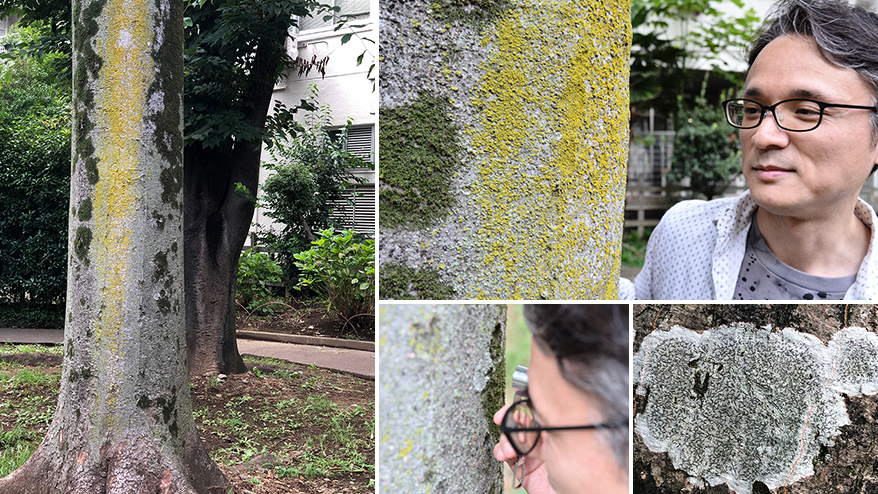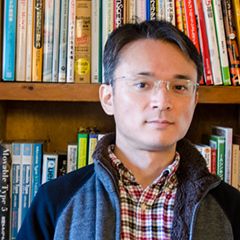こんにちは。品質管理部の村上です。
「出かける」ということに熱意をもてない引きこもり体質の私ですが、近頃少しだけ外を歩くのが楽しくなることができました。
それは歩きながら「地衣類」を探すことです。
いままでも野草を見ながら歩いてたりしてましたので、やっている事自体は傍目にはそんなに変わらないかもしれませんが、地衣類ならではの魅力があるのです。
※ 背中がぞわぞわするような写真があるかもしれません。苦手な方はご注意ください。
地衣類との出会い
皆さんは「地衣類(ちいるい)」というものをご存知でしょうか。
私の場合、本を読んでいるとときどき出てくるので以前から言葉としては知っていました。
ですが正確な意味は知らなくて、前後の文脈と使われている漢字から、コケとかシダとかの背丈の低い植物のことであろうかと想像していました。
それくらいの認識だった私が地衣類に興味を抱くようになったのは、数ヶ月前のことです。
昨年、会社の研修で徳島県にある TOEC(トエック)というフリースクールを訪ねる機会がありました。
研修自体は久しぶりに体を動かして楽しいものでしたが、その夜の食事のとき、外出されていた教師の方が戻ってこられてたまたま近くの席に座ることになりました。そこでその方が以前地衣類の研究をされていたということを伺って、自分もコケや野草など植物に少し興味をもっていたのでお話をさせていただきました。
そのときはまだ地衣類についてちゃんとした認識がありませんでしたから、今思うと少し的外れなことを話していたかもしれません。
ともあれ、そのときの会話で「地衣類」という言葉が私の中にそっと根をおろしたのでした。
それからしばらくは特に意識しないまま半分忘れていたのですが、今年の3月、国立科学博物館へ植物や粘菌などの膨大な標本を採集した学者である、南方熊楠(みなかたくまぐす、1867~1941年)の展示を見にいきました。
そこで同時に地衣類の展示もやっていて、そういえば TOEC の方が話していたものだったなと興味を惹かれ、熊楠展とも関連のある内容でもあったので見ていくことにしたのです。
そしてそこでやっと、地衣類とはどういうものかを知るにいたりました。
それまで「地衣類」とはコケなどの地面を覆うようにして生える植物の総称みたいなものだろうと軽く考えていたのですが、そうではなく全く別の生物だったのです。
今まで気にもとめていなかった存在に、にわかに興味を掻き立てられました。
地衣類とは?
地衣類という言葉はあまり聞き慣れないものかもしれませんが、じつは身近にも存在していて、都会でも小さなものなら意外と簡単に見つけることができます。
例えば、木の幹が黄色っぽくなっていたり、あるいは道端の古いコンクリートなどにオレンジがかったものがついているのを見たことがないでしょうか?
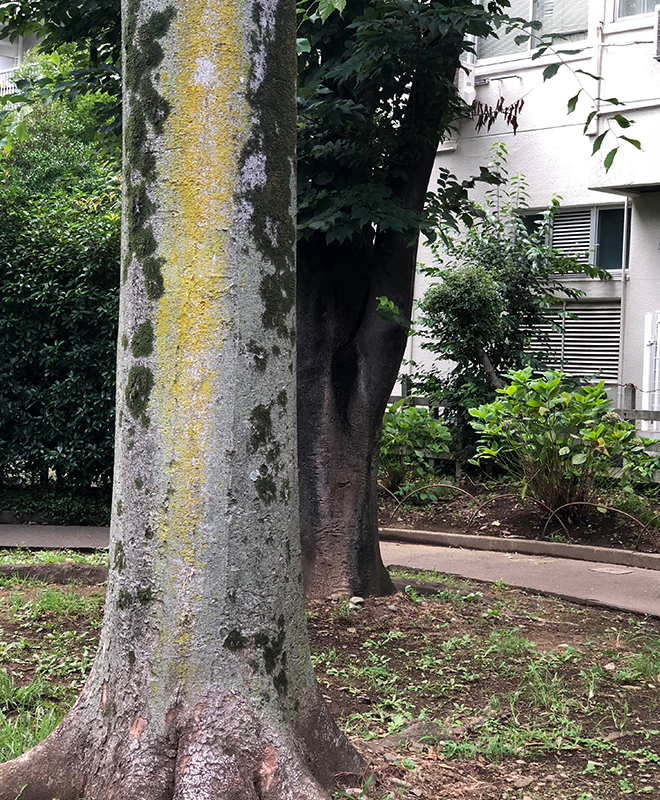
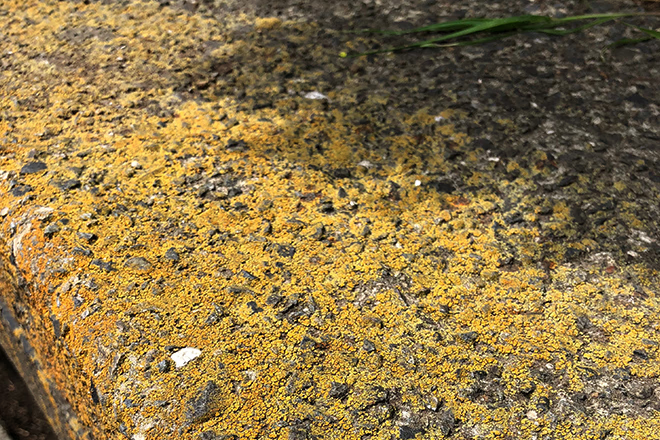
これらも地衣類の一種です。
コケかよごれのようにも見えますが、コンクリートの方の写真を拡大してみると…
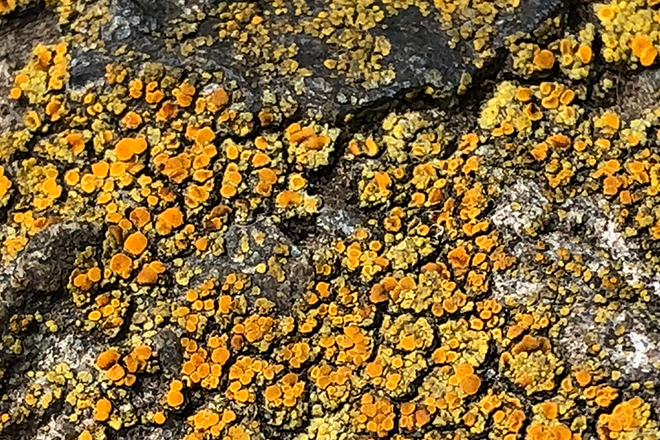
渋谷区にて。固着地衣のコウロコダイダイゴケかツブダイダイゴケの仲間だと思います
写真のように、コケとは違ったものが見えてきます。もちろんよごれでもありません。
コケ(コケ植物)は葉緑素を持つ植物の仲間で葉っぱを持っているのですが、写真にはそういったものは見当たりません。
そのかわり、拡大した写真にはつぶつぶがいくつも写っています。(私もまだ断言できるほど詳しくはないのですが)縁よりも内部が濃いオレンジになっているところは、胞子をつくる部分でしょう。
胞子。地衣類は胞子で増えます(他の増え方もします)。
コケも胞子で増えますが、コケではない。
じゃあ何かと言うと、菌類です。
地衣類はカビやキノコの仲間、ということです。
ちなみに菌類は植物ではなく、現在は動物や植物と対等に分類されているそうです(菌界・動物界・植物界)。キノコは植物ではないのですね。
地衣類はカビやキノコと見た目もずいぶん違いますが、最大の特徴は体の中に藻類が住んでいて、彼らが光合成でつくる栄養をもらって生きているという点です。
ですが、ただで栄養をもらうわけではなくて、かわりに藻類に住処を提供しています。藻類はそのおかげで生きていける場所が広がります。
地衣類と藻類は共生しているのです。
余談ですが、『となりの地衣類 地味で身近なふしぎの菌類ウォッチング』(盛口 満)によると、この日常的に使われている「共生」という言葉は、もともとは地衣類と藻類の関係を表したものだったそうです。
地衣類はすごく地味で小さいのに、奥が深い…。
また地衣類というのは名前に「コケ」とついているものがたくさんあります。
コケじゃないのにコケと呼ばれているなんて変な気もしますが、コケというのは古くは「木毛」と書いたらしく、そこにはコケ植物も菌類である地衣類も含まれていて、そのため今も地衣類に「コケ」という名前がついているそうです。
かなり乱暴な説明ではありますが、地衣類のこと、多少なりともお伝えできたでしょうか。
地衣類を探して
さて、興味を持ったら自分の目で実際に探してみたいと思うもの。
地衣類は大気汚染に敏感で、大気汚染を測る指標になる種類もあるほど。都会では探すのは難しいだろうかとはじめは思っていたのですが、本当に身近で見つけることができました。
ビルをひとつ挟んで首都高と甲州街道が走っているようなところにも生えていました。
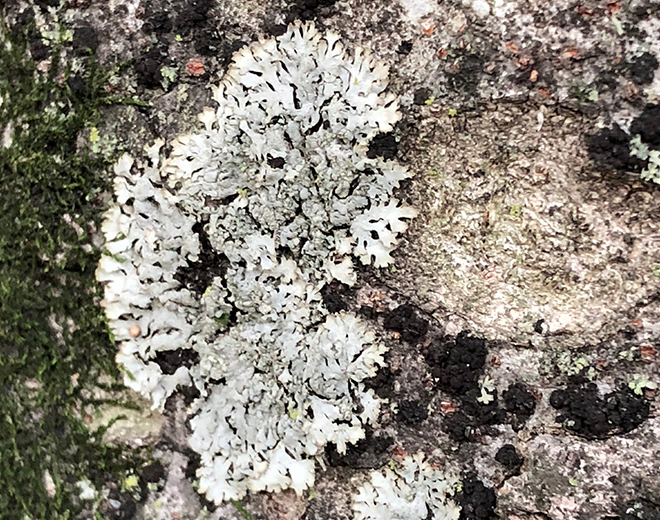
渋谷区にて。葉状地衣のコカゲチイかコフキメダルチイ(コフキヂリナリア)でしょうか。この仲間もまだ私には同定が難しいです
次は調布市のお寺に生えていたもの。場所によって違った種類のものが見られます。
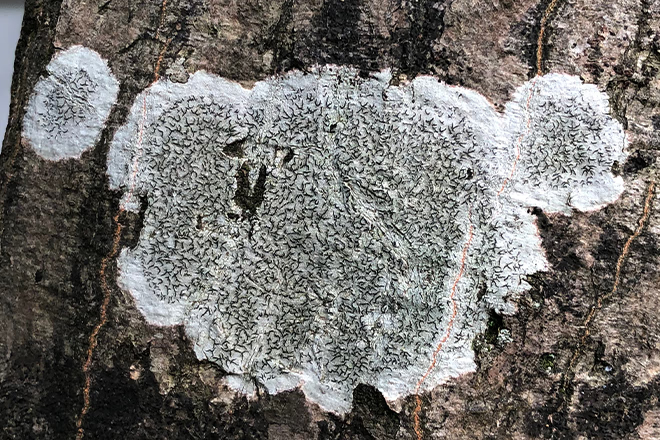
調布市のお寺の境内にて。固着地衣のモジゴケの仲間。黒くて細い、線のようなところが胞子をつくる器官(子器)です
地衣類はたいてい、何年も前からあるような石やコンクリート、樹の幹などに生えているため、そういう場所を探しています。
観察には、肉眼ではわからないことも多いので、私はスマホの拡大機能を使っています。写真もスマホで撮影、それを『街なかの地衣類ハンドブック』(大村 嘉人)と突き合わせて何という種類なのか調べています。
ルーペも持っているのですが、街中だと怪しい人と思われてしまいそうで、あまり使っていないです。しゃがみこんでスマホで地面を撮っているだけでもすでに怪しいかもしれませんが…。
はじめは見つけるのも見分けるのも難しかったのですが、最近になってやっと「あ、これは地衣類だな」となんとなくわかるようになってきました。
(とはいえ、合っているのかどうかを誰かにみてもらったわけではないので、まだまだ間違いも多いかもしれません。素人でも参加できる観察会がないか探しているところです)
最初は地衣類なのかどうかよくわからなかったものが、なんとなくそうだとわかってくる。どういう種類なのか、見当がつくようになってくる。
相手のことがわかってくると愛着も湧いてくるものです。
地衣類を探していると、同じ景色を見ていても今まで見えていなかったものが見えてきて、視野が広がるというか、レイヤーが増えるようなイメージでしょうか。
何十回も通ったことのある場所でも、ふといつもと違うところに目をやると、それまで全然気づかなかった地衣類が生えていたりするのです。「あ、こんなところにも生えていたのか」と。
地衣類に興味を持つまでは、たとえ視界に入っていたとしても、何かが生えていることにすら気づかなかったでしょう。
こういった、新しく発見することの喜びや感動はまだ地衣類の世界の入り口に立ったばかりだからこその新鮮さなのかもしれませんが、これからも失わずにいたいものです。
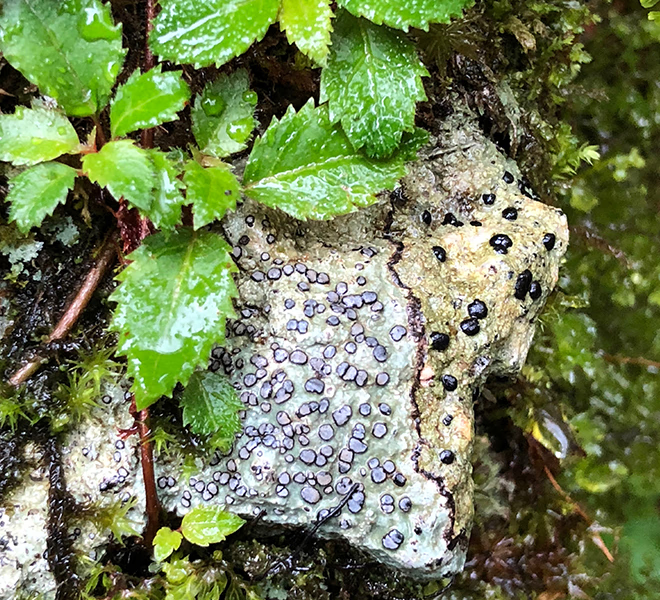
屋久島 白水雲水峡にて。左側の灰色のつぶつぶがある方はおそらく固着地衣のヘリトリゴケ。右側の黒いつぶつぶの方は不明。中央の縦に走る黒い線は、2つの地衣の境い目です。
そもそも私が草花などに興味をもつようになったのは亡くなった祖父の影響も多分にあると思います。
祖父は地域の植物についてもっとも詳しい人物の一人(だったと思う)で、幼い頃は散歩やわらび採りをしながら植物のことなどを教えてもらっていました。
私は採集もしていませんし、生物についての勉強をしているわけでもありませんが、そういったことへの興味を失わないことは祖父を忘れないことだという意識が今もどこかにあるのかもしれません。
祖父から地衣類の話をしてもらった記憶はありませんが(教えてもらったとしても、当時の私は興味を示さなかったでしょうし…)熊本の実家付近にもきっと地衣類が生えているはず。今度帰ったときには探してみるつもりです。
すぐとなりにあったけれども、幼い頃には気づかなかった世界が見えるかもしれないと思うと、とても楽しみです。
参考文献:
大村 嘉人 2016『街なかの地衣類ハンドブック』文一総合出版
盛口 満 2017『となりの地衣類 地味で身近なふしぎの菌類ウォッチング』八坂書房
